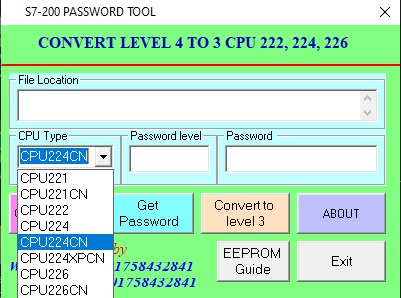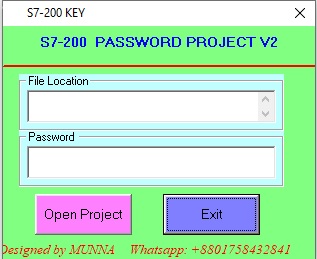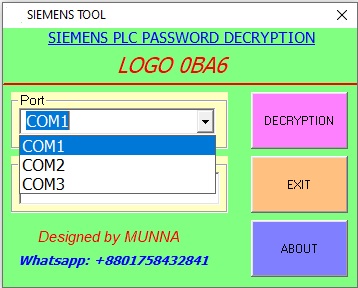I. Introduction to Siemens PLC Passwords
Siemens Programmable Logic Controllers (PLCs) play a vital
role in industrial automation by controlling and monitoring machinery and
processes. With this high level of control comes the need for security
measures, and Siemens PLCs are protected by passwords to prevent unauthorized
access.
Unlocking Siemens PLC Passwords: A Free and Efficient Solution
A. Importance of PLC Passwords
The security of PLC passwords is crucial to safeguarding
sensitive data, intellectual property, and production processes. Password
protection ensures that only authorized personnel can modify or access the PLC
programs, preventing potential disruptions, sabotage, or unauthorized
tampering.
B. Challenges in Unlocking Siemens PLC Passwords
However, there are instances where the password for a
Siemens PLC is forgotten or misplaced, causing significant challenges for
users. With locked PLCs, troubleshooting issues, making necessary
modifications, or even routine maintenance tasks become nearly impossible
without the password.
II. Understanding Siemens Programmable Logic Controllers (PLCs)
A. Overview and Applications
Siemens PLCs are widely used across various industries,
including manufacturing, energy, transportation, and more. These advanced
devices are designed to control complex automation processes, optimize
productivity, and improve operational efficiency.
B. Security Measures: PLC Password Protection
To ensure the security and integrity of the programs running
on Siemens PLCs, password protection is integrated into the operating system.
The passwords act as a shield against unauthorized access, protecting sensitive
data, and preventing malicious intrusions.
III. Restrictions of Locked Siemens PLCs
A. Consequences of Forgotten Passwords
Forgotten or lost passwords can lead to significant business
disruptions, as it becomes challenging to resolve technical issues and make
necessary changes to the PLC program. The downtime caused by locked PLCs can
result in production delays, financial losses, and increased maintenance costs.
B. Accessing Locked PLCs: Legal and Ethical Implications
Attempting to access locked PLCs without proper
authorization raises legal and ethical concerns. It is essential to respect
intellectual property rights and comply with legal regulations. Therefore, it
is crucial to explore authorized methods for unlocking Siemens PLC passwords.
IV. Siemens PLC Password Unlocking Methods
A. Common Approaches Explored
- Manufacturer
Support
Seeking assistance from the manufacturer is a common
approach when dealing with locked PLCs. Contacting the Siemens support team can
provide insights and possible solutions. However, this process may involve
lengthy communication and potential costs.
- Hardware
Manipulation
Another method is hardware manipulation, which involves
physical intervention on the PLC device to bypass or reset the password. This
approach often requires technical expertise and can potentially void warranties
or damage the PLC.
- Software-based
Solutions
Software-based solutions present an alternative approach to unlocking
Siemens PLC passwords. These solutions utilize algorithms and techniques to
recover or reset the passwords without tampering with the hardware.
B. Limitations and Risks of Conventional Methods
Conventional methods, such as manufacturer support and
hardware manipulation, may not always be efficient or feasible. They can be
time-consuming, expensive, and carry risks of accidental damage. As a result,
users are increasingly turning to software-based solutions for a more
streamlined and reliable password unlocking process.
V. Introducing the Siemens PLC Password Unlocker
A. Features and Functionality
The Siemens PLC Password Unlocker is a revolutionary
software designed to provide a secure and efficient password unlocking solution
for locked Siemens PLCs. It employs advanced algorithms and techniques to
recover or reset the password without compromising the integrity of the PLC's
programs or data.
B. Benefits over Traditional Methods
Compared to traditional methods, the Siemens PLC Password
Unlocker offers several advantages.
VI. Downloading and Installing the Siemens PLC Password Unlocker
A. Ensuring Compatibility with Siemens PLC Models
Before downloading the Siemens PLC Password Unlocker, it is
essential to ensure compatibility with the specific Siemens PLC model being
used. The software documentation provides comprehensive information on
compatible PLC models and firmware versions.
B. Step-by-Step Installation Guide
- Download
the Siemens PLC Password Unlocker software from the official website.
- Extract
the software package to a designated folder on your computer.
- Initiate the installer and adhere to the prompts displayed on the screen to finalize the installation procedure.
- After installation, verify that the software is connected to the internet for updates and assistance.
VII. Unlocking Siemens PLC Passwords with the Siemens PLC Password Unlocker
A. Launching the Unlocker Software
After successful installation, launch the Siemens PLC
Password Unlocker software from the desktop shortcut or the installed location.
The user-friendly interface provides easy navigation and access to the password
unlocking features.
B. Guided Password Recovery Process
- Connect
the locked Siemens PLC to your computer using a compatible communication
interface.
- Within
the Siemens PLC Password Unlocker software, select the appropriate PLC
model and communication protocol.
- Follow
the guided process to initiate the password recovery operation.
- The
software will employ its algorithms to recover or reset the password,
allowing you to regain access to the locked PLC.
VIII. Frequently Asked Questions
A. Can the Siemens PLC Password Unlocker be trusted?
Yes, the Siemens PLC Password Unlocker has been extensively
tested and verified by experts in the field. It ensures the safety and
integrity of the PLC programs and data throughout the password recovery
process.
B. Is the Siemens PLC Password Unlocker compatible with all PLC models?
The Siemens PLC Password Unlocker supports a wide range of
Siemens PLC models, including popular series such as S7-200, S7-300, S7-400,
and S7-1200. However, it is essential to refer to the software documentation
for specific compatibility information.
C. Is the password unlocking permanent or temporary?
The password unlocking performed by the Siemens PLC Password
Unlocker is permanent, allowing users to regain full control over their locked
PLCs without any time limitations.
D. What precautions should be taken while using the Siemens PLC Password
Unlocker?
When utilizing the Siemens PLC Password Unlocker, it is
crucial to strictly adhere to ethical and legal guidelines. Ensure that the PLC
being unlocked is owned by you or authorized for maintenance and modifications.
Respect intellectual property rights and refrain from using the software for
any malicious purposes.
IX. Advantages and Disadvantages of Using the Siemens PLC Password Unlocker
A. Pros of Unlocking Siemens PLC Passwords
- Fast
and efficient password recovery process
- Avoids
risks associated with hardware manipulation
- Cost-effective
compared to traditional methods
- Secures
the integrity of PLC programs and data
B. Cons and Limitations of the Unlocker Software
- Compatibility
restrictions with specific PLC models
- Requires
a reasonable level of technical understanding
- Ethical
considerations should be taken into account
X. Case Studies: Real-Life Experiences with the Siemens PLC Password
Unlocker
A. Success Stories
Numerous users have successfully utilized the Siemens PLC
Password Unlocker to unlock their locked PLCs and regain control over their
processes. These success stories highlight the efficiency and reliability of
the software.
B. Challenges Faced and Lessons Learned
While the Siemens PLC Password Unlocker has proven to be a
highly effective tool, users have encountered challenges in certain scenarios.
Understanding these challenges helps users set realistic expectations and
employ alternative strategies if needed.
XI. Alternatives to the Siemens PLC Password Unlocker
A. Other Commercial PLC Password Unlocking Tools
Various commercial solutions exist in the market for
unlocking PLC passwords. Users can explore alternative software options that
cater to their specific requirements and are compatible with their PLC models.
B. Consulting Professional Services
If unlocking the PLC password becomes exceedingly complex or
time-consuming, seeking assistance from professional services specializing in
PLC password recovery and maintenance can provide valuable solutions.
XII. Conclusion
A. Recap of Siemens PLC Password Unlocker's Benefits
The Siemens PLC Password Unlocker offers a free and
efficient solution for unlocking passwords on locked Siemens PLCs. With its
advanced algorithms and user-friendly interface, the software provides a secure
and streamlined password recovery process.
B. Empowering Users to Regain Control
By eliminating the barriers caused by forgotten or misplaced
passwords, the Siemens PLC Password Unlocker empowers users to maintain
operational efficiency, save time, and prevent potential financial losses
associated with locked PLCs.



omron plc password
unlocker
plc hmi password unlock
v4.2 free download
siemens
plc password unlocker
all plc and hmi
password unlock crack v2.3
delta plc password
unlock
delta plc password
unlock software
delta plc password
unlocker
fatek plc password
unlock
fatek plc password
unlock software free download
logo plc password
unlock
logo plc password
unlock software free download
plc hmi password unlock
software free download
unlock password plc
delta tool software download
mitsubishi plc password
unlock software
s7 200 smart plc
password unlock
all plc unlock bd
software v4.2
plc hmi password unlock
v4.2 free download
plc hmi password unlock
v4.2
s7 200 smart plc
password unlock
unlock password plc s7
300
Siemens PLC Password unlocker FREE Download
- ALL PLC UNLOCK SOFTWARE FREE DOWNLOAD v4.2
- Panasonic PLC Password unlocker Free Download
- Siemens PLC Password unlocker FREE Download
- Fatek plc password unlock software free download
- OMRON PLC Password Unlocker FREE Download
- Mitsubishi FX3U plc password Unlock
- Fuji Hakko HMI password unlock Free Download v6 v7 v8 UG Series
- omron plc password crack tool free download
- mitsubishi plc password crack software free download
- delta plc password unlock software free download
- ls plc password unlocker free download
- siemens plc password unlocker free download
- fatek plc password unlock software free download
- panasonic plc password cracker free download
- Unlock Password Rockwell Allen Bradley Micrologix
- vigor plc password unlock
- Crack Password PLC FUJI
- xinje plc password crack
- proface hmi password crack
- fuji hmi password crack
- mitsubishi hmi password cracker
- weintek hmi password unlock
- idec hmi password unlock
- hitech hmi password crack
- plc unlock software
- unlock password plc crack all plc & hmi v2.2.1 free download
- s7-200 plc unlock autechvn download
- crack all plc hmi passwords rar
- crack all plc & hmi v2.3 download
- recover password plc dvp delta
- plc hmi password unlock v4.2 free download
- fatek plc password unlock software free download
- all plc hmi password key free download
- unlock password plc crack all plc & hmi v2.2.1 free download
- plc & hmi password decryption download
- mitsubishi plc password crack software free download
- ALL PLC UNLOCK SOFTWARE FREE DOWNLOAD v4.2
- Panasonic PLC Password unlocker Free Download
- Siemens PLC Password unlocker FREE Download
- Fatek plc password unlock software free download
- OMRON PLC Password Unlocker FREE Download
- Mitsubishi FX3U plc password Unlock
- Fuji Hakko HMI password unlock Free Download v6 v7 v8 UG Series
- omron plc password crack tool free download
- mitsubishi plc password crack software free download
- delta plc password unlock software free download
- ls plc password unlocker free download
- siemens plc password unlocker free download
- fatek plc password unlock software free download
- panasonic plc password cracker free download
- Unlock Password Rockwell Allen Bradley Micrologix
- vigor plc password unlock
- Crack Password PLC FUJI
- xinje plc password crack
- proface hmi password crack
- fuji hmi password crack
- mitsubishi hmi password cracker
- weintek hmi password unlock
- idec hmi password unlock
- hitech hmi password crack
- plc unlock software
- unlock password plc crack all plc & hmi v2.2.1 free download
- s7-200 plc unlock autechvn download
- crack all plc hmi passwords rar
- crack all plc & hmi v2.3 download
- recover password plc dvp delta
- plc hmi password unlock v4.2 free download
- fatek plc password unlock software free download
- all plc hmi password key free download
- unlock password plc crack all plc & hmi v2.2.1 free download
- plc & hmi password decryption download
- mitsubishi plc password crack software free download



